Heat is Sexual Wishlist (2014) Watch onlinean inevitable byproduct of work. It's generated when you start a car's engine, go for a brisk walk or anything else that generates friction. Heat is also prevalent in electronics where it can be more difficult to manage and can be detrimental to their continued operation. When it comes to graphics cards there are many ways to manage heat, from passive cooling, to fans and even water. But when these solutions aren't working, your GPU has one more way to beat the heat: thermal throttling.
When your GPU takes on a heavy workload, such as gaming, it generates a load of heat. When your cooling solution can no longer dissipate heat fast enough to keep temperatures within a safe range, your graphics card starts to dump performance to shed heat. The core and memory frequencies begin to drop---along with your framerates---until temperatures drop to a safe operating range. All modern GPUs have this feature in place to protect the electronic components from damage. Unmanaged, thermal throttling can have a big impact on performance. And, while thermal throttling itself doesn't cause any damage, the underlying cause of throttling, heat, can cause damage and shorten the lifespan of your video card.
In order to maintain performance, you need to control heat, but not all graphics cards experience throttling to the same degree, or even at all. There are a variety of scenarios that determine the impact thermal throttling has on your system. Case selection, cooling solution, and airflow are the three main factors to take into consideration.
A small case with no open space traps heat and inhibits airflow, which makes it harder to keep your GPU cool. Choosing a larger, well laid out case can provide more fan mounts and options to optimize airflow. Being able to mount additional fans in your case is especially beneficial if your GPU manufacturer has used a custom cooling solution that dissipates heat into your case instead of directly removing it, like with reference designs.
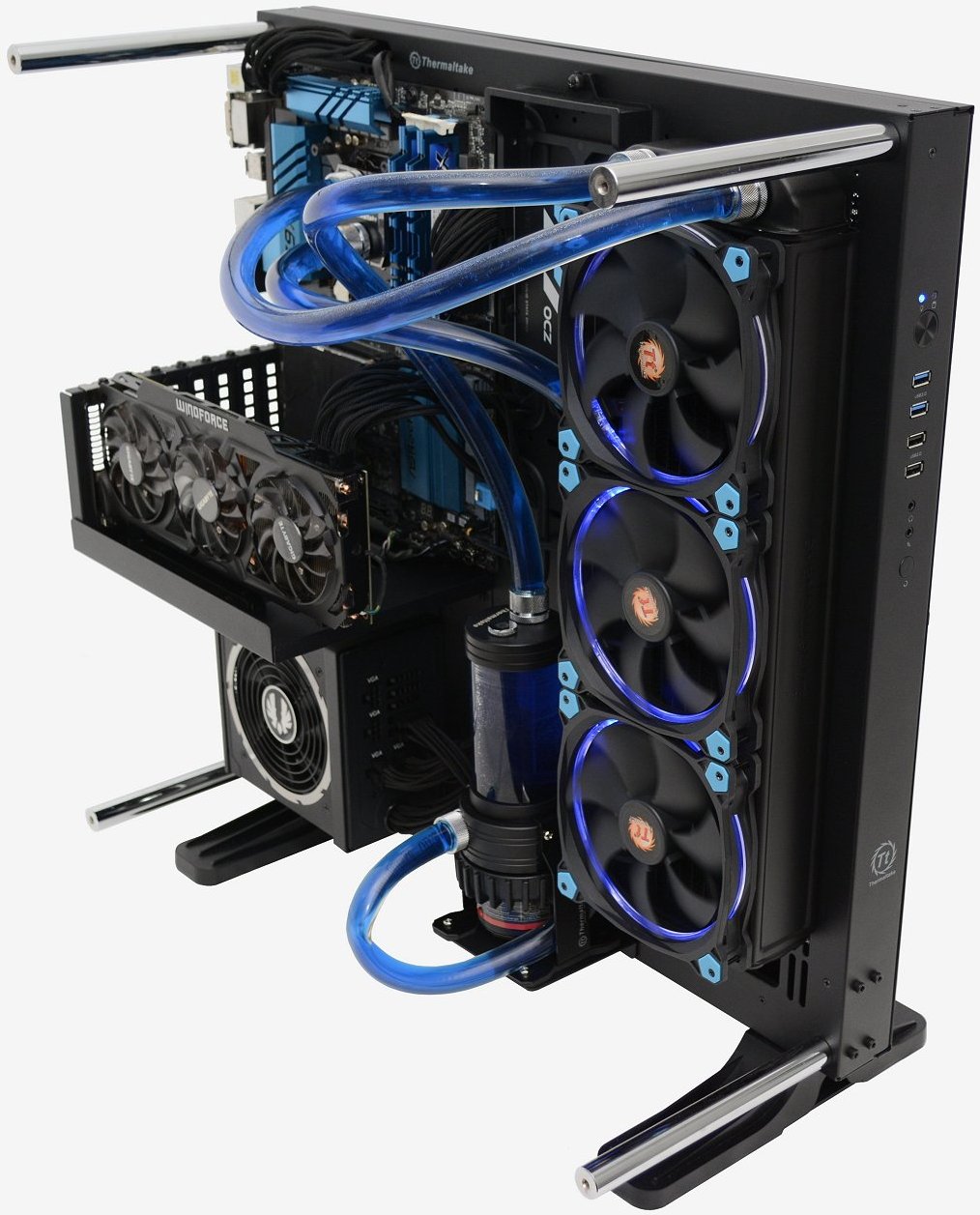
Adding additional fans to the top of your case ensures that heat generated by your GPU is removed from the case efficiently. It also lowers air temperature inside of your case keeping other components, such as your CPU and memory, much cooler.
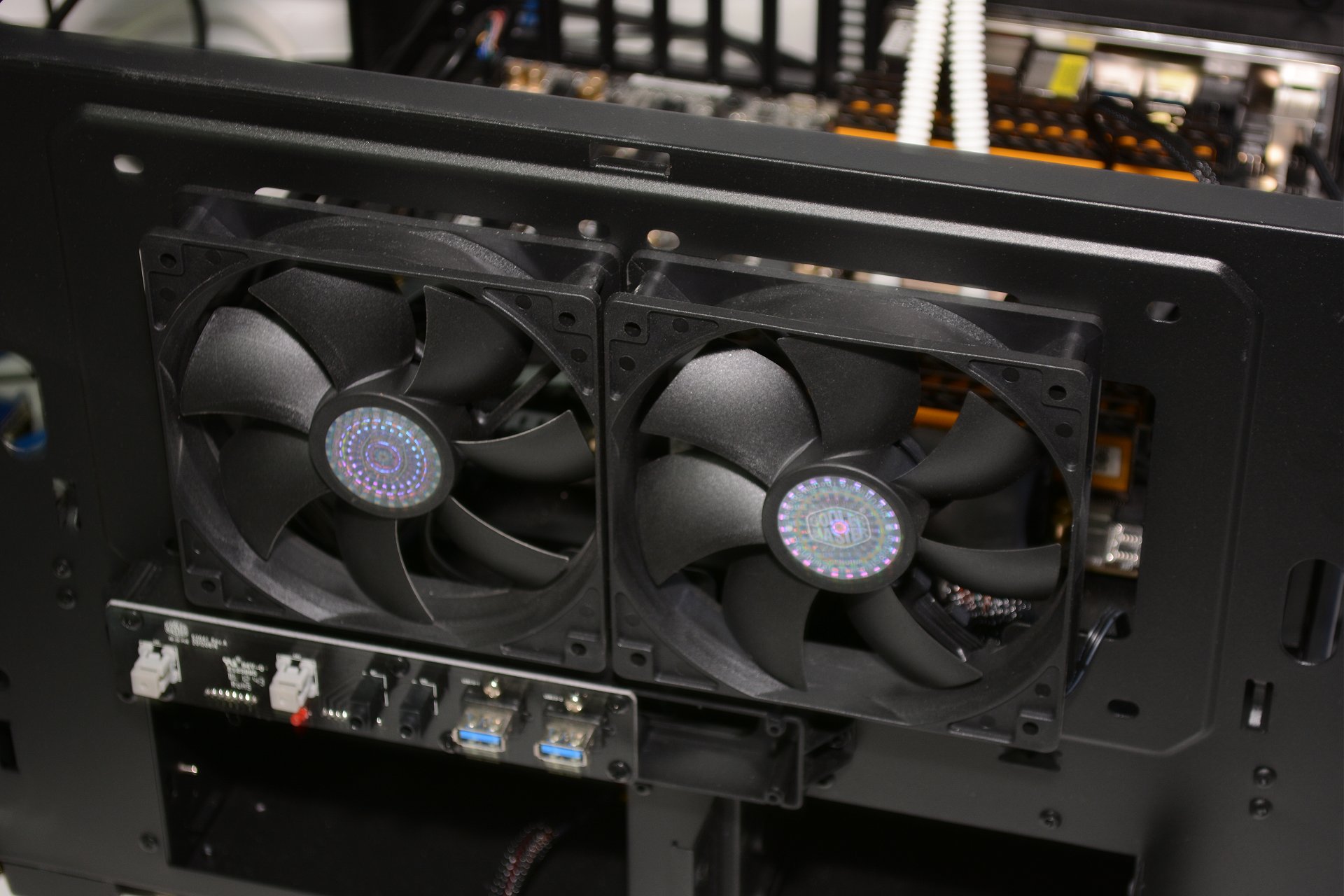
The brand of graphics card you choose may come down to personal preference, but the cooling solution it uses is an important decision. Reference designs---which are blower-type fans---typically use a single fan to keep the card cool. Cool air is drawn through the rear of the graphics card and exhausted out of the end with the connectors. This design is efficient but the single fan holds back performance.
When choosing a graphics card, it's often ideal to pick one with a multi-fan cooling solution. The additional fans---sometimes as many as three---provide enough airflow to significantly reduce or even eliminate throttling. It should be noted that your case needs to provide enough airflow to handle the hot air pumped out by these types of graphics cards as their coolers do not directly remove the heat from the case.
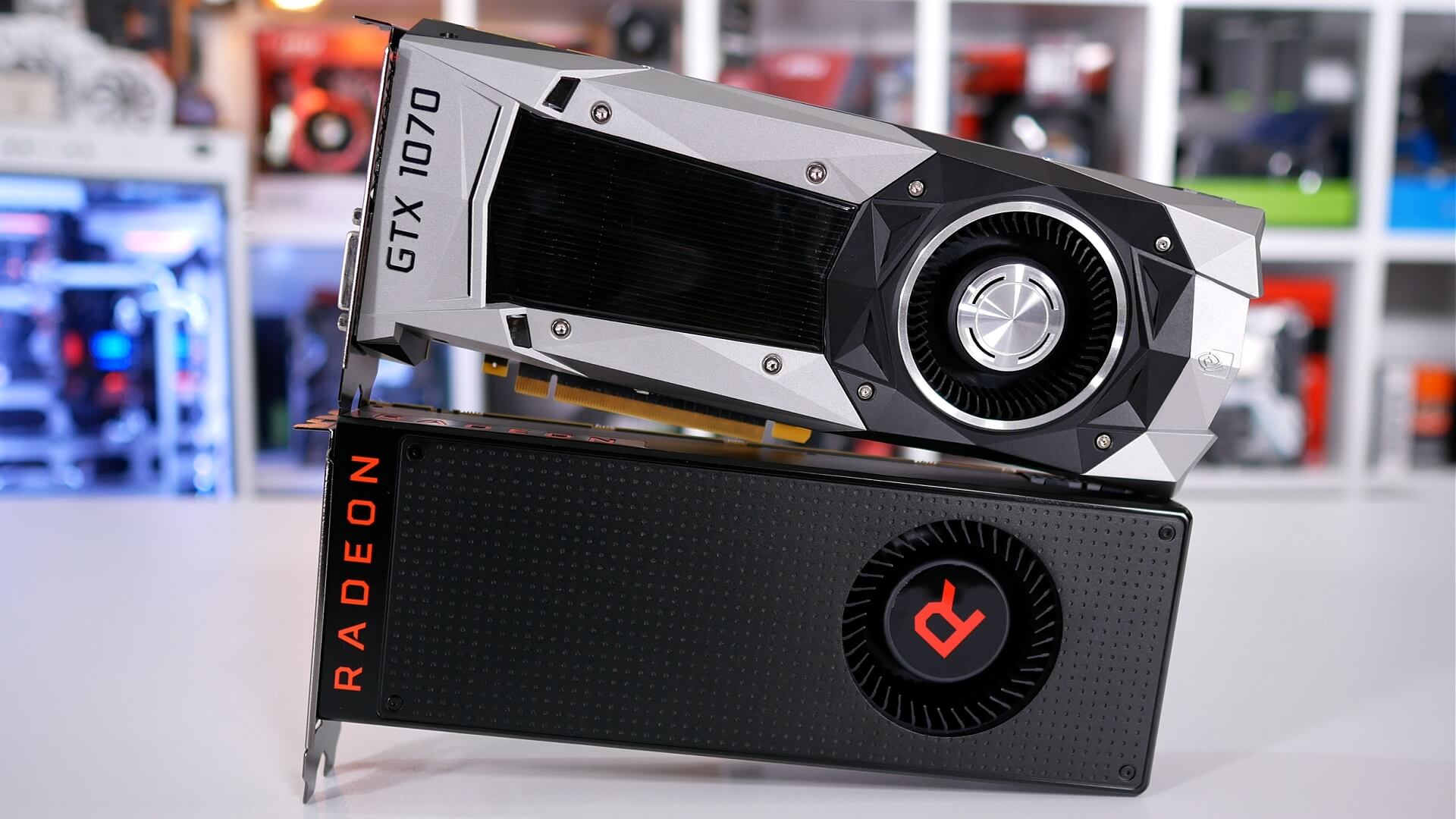
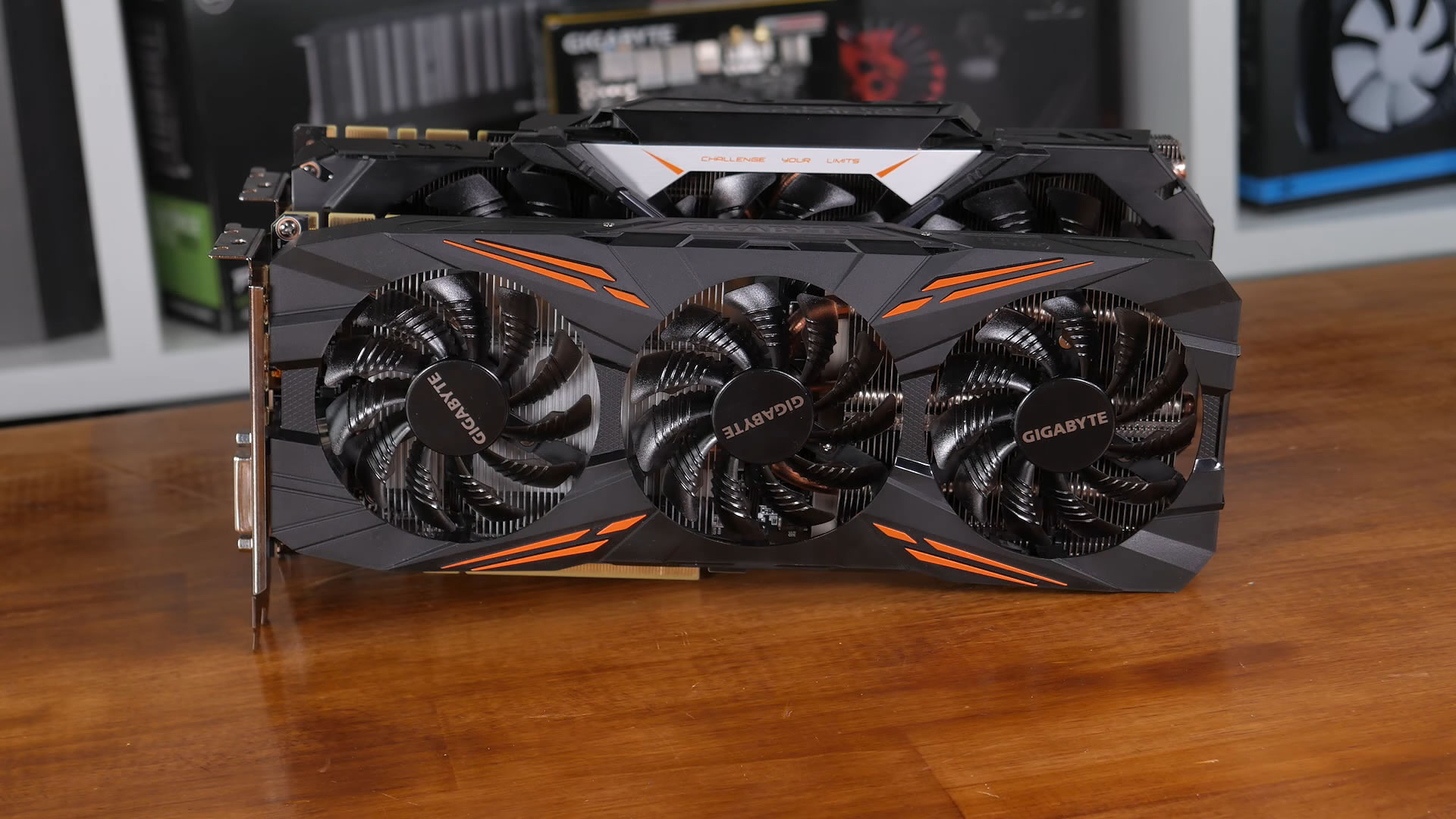
If changing or adding hardware is not an option, you can still reduce temperatures using freely available tools.
With utilities like MSI's Afterburner or EVGA's PrecisionX, a custom fan curve can be configured. By setting the fan curve manually, you can set the fan speed for a given temperature to something a bit more aggressive. From the factory, the fan speeds are optimized to strike a balance between noise and performance. With reference cards, this balance often leans more towards noise suppression and can lead to thermal throttling.
Noise levels will increase, perhaps significantly, but your GPU will be able dissipate heat much faster and maintain performance.
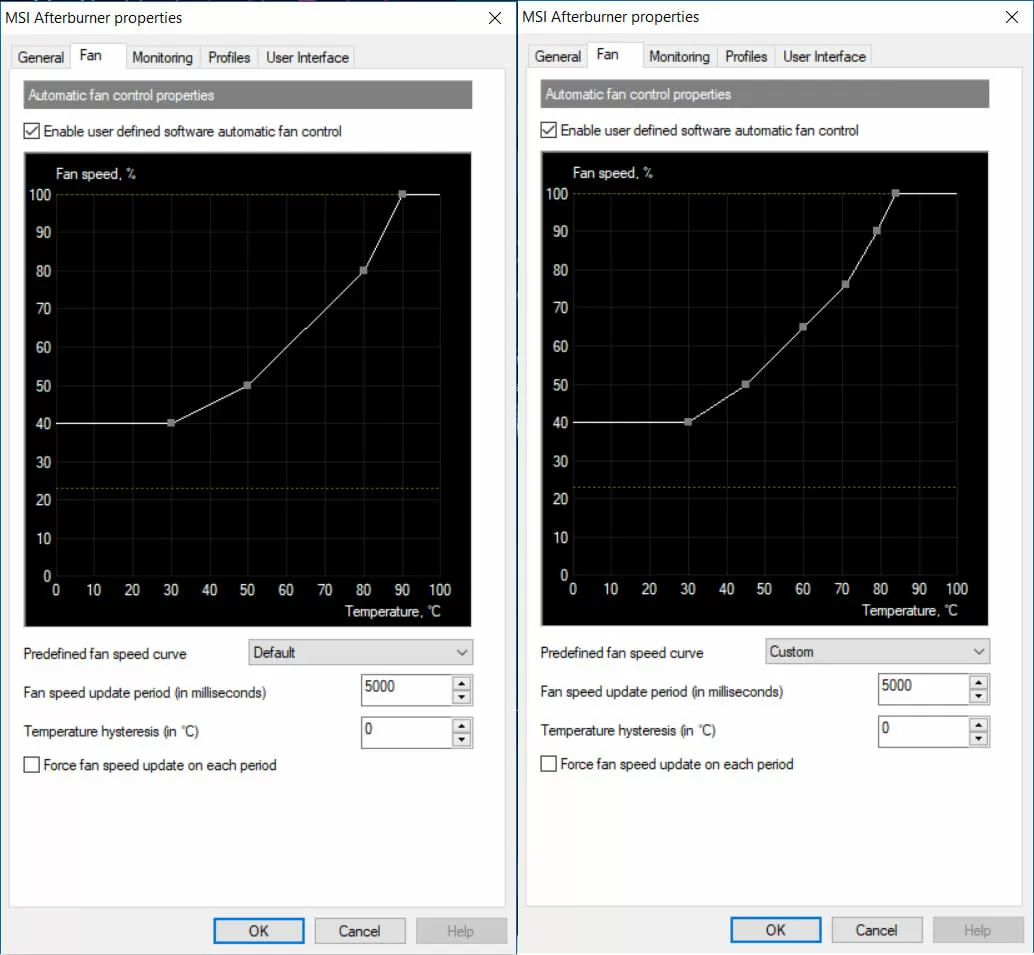
Default Left, Custom Right
If the additional fan noise is too much to handle, there is one more solution to your thermal throttling woes: undervolting.
Sometimes the amount of voltage your card uses is set higher than it needs to be to allow your card to function correctly. Running at a higher voltage generates more heat even if the clock and memory speed remain the same. Undervolting your graphics card by even a small amount can lower temperatures enough to reduce or even eliminate thermal throttling. However, this isn't a guaranteed solution and can cause stability issues. For most users, we recommend a combination of better cooling in conjunction with fan-curve adjustments.
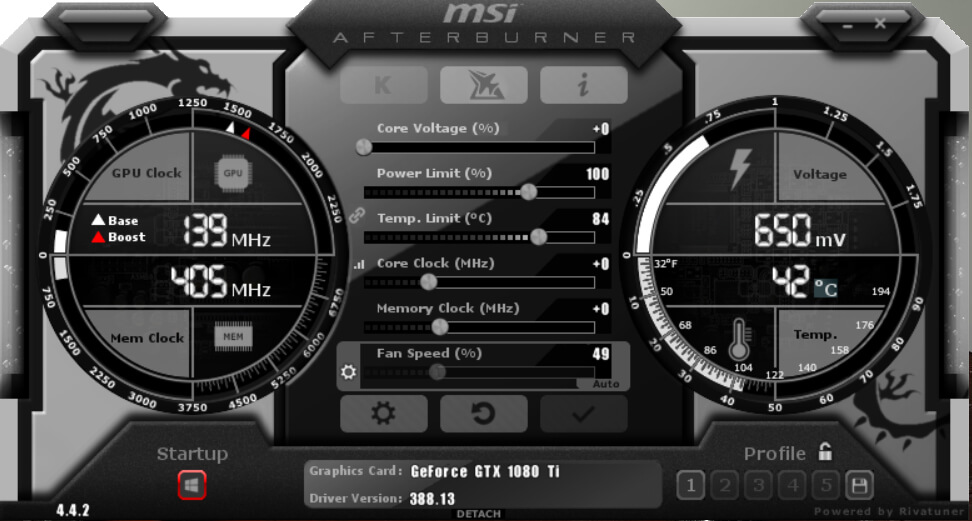
Most monitoring tools are capable of more than just controlling GPU fans and altering voltage. They also monitor temperatures, core and memory frequencies, along with GPU usage. Most of them also offer at least basic overclocking capability. This is important because your can't prevent something that you can't see.
Monitoring your GPU's temperature, along with core and memory frequencies, allows you to determine when you're experiencing throttling. It's important to note that there are a few things to look for before you need to break out the utilities. If you are experiencing stuttering or notice a visible drop in frame rate, it's likely that your video card has slowed down to shed heat. If you haven't altered your video card's fan curve and the fan is starting to sound like a jet engine, there is a good chance you've hit the throttling point. You can then confirm this with the tool of your choice.
If your temperature exceeds your graphics card's throttling point and your frequencies start to drop, you know it's time to look at your cooling. Ideally you want temperatures to be as low as possible, anything below 80 degrees is normal and should keep throttling in check. Nvidia's GTX 1080 Ti, for example, has a throttling point of 84 degrees. If you keep the temperature below 80 degrees you leave yourself with a bit of breathing room, so you can focus on having fun instead of monitoring GPU frequencies.
It's important to remember that every graphics card has a different throttling point. The previous-gen GTX 980 and 970, for example, throttle at 80 degrees, while AMD's Vega series cards can reach a maximum temperature of 85 degrees before they throttle. You will need to find out the throttling point for your specific card in order to set an effective fan curve and voltage.
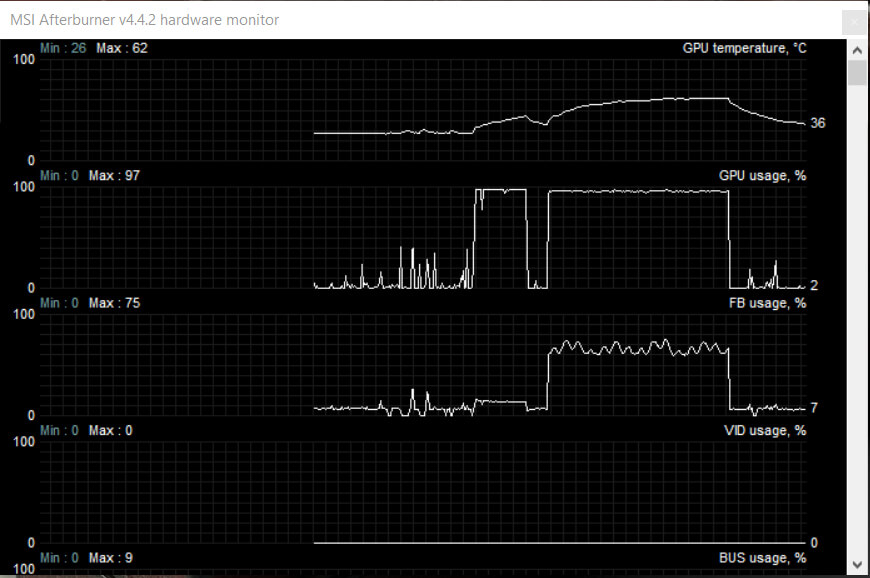
When deciding which utility to use, it's important to consider the scope of what you are going to be monitoring. If you are going to focus on your graphics card, then I recommend MSI's Afterburner or Asus Tweak. Either of these tools will provide all the monitoring and configuration options you could possibly need, including overclocking.
If you want to monitor your whole system, you'll need to look at something else, such as NZXT's Cam software. While Cam does monitor your entire system, it doesn't offer as many options for tweaking your graphics card. It doesn't hurt to install more than one utility to get a wider range of monitoring features.
 NYT Connections hints and answers for May 18: Tips to solve 'Connections' #707.
NYT Connections hints and answers for May 18: Tips to solve 'Connections' #707.
 Newscaster uses Taylor Swift lyrics to deliver her traffic report
Newscaster uses Taylor Swift lyrics to deliver her traffic report
 Lyft is making a move to Canada to take on Uber internationally
Lyft is making a move to Canada to take on Uber internationally
 The Walking Dead Season 8, episode 4 recap: The saddest death yet?
The Walking Dead Season 8, episode 4 recap: The saddest death yet?
 Gods of War
Gods of War
 'Stranger Things' nail art is here and weird and we love it
'Stranger Things' nail art is here and weird and we love it
 GM unveils the latest and greatest Corvette, the 2019 ZR1
GM unveils the latest and greatest Corvette, the 2019 ZR1
 No, this isn't a real conversation between Bill Clinton and Tony Blair
No, this isn't a real conversation between Bill Clinton and Tony Blair
 Best rope light deal: Save 25% on Lepro N1 AI Smart RGB LED Strip Lights
Best rope light deal: Save 25% on Lepro N1 AI Smart RGB LED Strip Lights
 The other 'Stranger Things' child experiments and their powers
The other 'Stranger Things' child experiments and their powers
 The internet is talking like Kevin from 'The Office' now
The internet is talking like Kevin from 'The Office' now
 Lyft is making a move to Canada to take on Uber internationally
Lyft is making a move to Canada to take on Uber internationally
 Global warming emissions hit record high in 2017 as Paris goals slip
Global warming emissions hit record high in 2017 as Paris goals slip
 Dunkin' Donuts will sell holiday cookie
Dunkin' Donuts will sell holiday cookie
 The strangeness of Japan's decision to start openly hunting whales
The strangeness of Japan's decision to start openly hunting whales
 Qualcomm just killed the world's biggest tech deal
Qualcomm just killed the world's biggest tech deal
 Film distributor cancels releases of Louis C.K.'s 'I Love You, Daddy'
Film distributor cancels releases of Louis C.K.'s 'I Love You, Daddy'
 Newscaster uses Taylor Swift lyrics to deliver her traffic report
Newscaster uses Taylor Swift lyrics to deliver her traffic report
 NYT Strands hints, answers for May 2
NYT Strands hints, answers for May 2
 $80,000 baby sculpture leaves New Yorkers alarmed over a piece of art
$80,000 baby sculpture leaves New Yorkers alarmed over a piece of art
More Beatles jams are headed to Netflix with Season 2 of 'Beat Bugs'Emilia Clarke headed to 'Star Wars' universe for young Han Solo filmMike Pence gets quite the icy welcome at 'Hamilton'Steve AokiThere's already a plan to fight Trump's Muslim registry, and it's brilliantAirbnb's update can help you make extra cash as a tour guideWe need to talk about Cam Newton's fox tail cleats6 burning questions we have after viewing 'Fantastic Beasts'NBA player delivers flawless Conor McGregor impression'Hamilton Mixtape' releases killer new tunes with a cameo from LinKlay Thompson casually swigs a beer during postCrows are now acting like magpies and attacking people in AustraliaTwitter CEO apologizes for white supremacy adApple celebrates the march of technology in grandiose new adKanye West just said he would have voted for Trump and people can't copeKanye West basically outlined his 2020 presidential platform last night'The Grand Tour' will stream worldwide as Amazon Prime Video expands'Family Guy' writer talks about tackling YouTube Red’s first animated seriesThis cheap, folding helmet is exactly what bikeDog devastated to realize bone painted on bowl is not an actual bone 'The Purge' is back on July 4 and the first poster wants to MAGA Why I, a politics nerd, will never watch a Trump State of the Union Diane Keaton is standing by Woody Allen Report: iOS 12 will focus on stability instead of big features Nicole Kidman eats live bugs, deserves at least four more Oscars Police arrest 5 people after finding 4,000 kilos of oranges in their cars Mom can't stop laughing after she learns the word 'queef' 'Black Panther' currently winning most advance ticket sales for superhero movie Little girl found the creepiest sock and shoe combination imaginable An ode to the delightfully unhinged Lisa Frank Facebook page How Alexa, your computer, and even your sex robot can affect your love life Thank Nintendo's failed Wii U for the Switch's wild success Why this Netflix Original is the Bonnie & Clyde of our generation How 2018 can be the year for Latinx representation 'House of Cards' adds Diane Lane, Greg Kinnear for the show's final season Paris Hilton dresses up as Kim Kardashian and oh how the tables have turned Chrissy Teigen, John Legend donate $200,000 on behalf of U.S. gymnasts Mozilla updates Firefox Quantum to fix huge security vulnerability Child advocates call on Facebook to discontinue 'Messenger Kids Dolly Parton responds to Adele's Twitter tribute with heartfelt message
2.5631s , 10156.5703125 kb
Copyright © 2025 Powered by 【Sexual Wishlist (2014) Watch online】,Creation Information Network